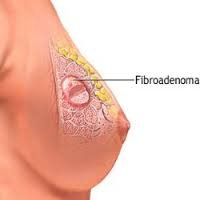
Fibroadenoma of the Breast
Fibroadenoma is a non-cancerous lump that occurs in the breast. It can occur in any age group. But mostly affects young women.
Fibroadenoma has a round well-defined structure that can be hard and soft. it can be painful or painless.
Fibroadenoma in menopausal age shrinks down itself due to decreased levels of estrogen.
Causes of Fibroadenoma of the Breast:
History of the contraceptive pill especially in the age before 20 may cause excessive secretion of estrogen that is the main factor for growing lump in the breast. fibroadenoma grows during pregnancy and stops growing during menopause.
1. Genetic factors may play an important role in this.
Types of fibroadenoma:
1. Simple fibroadenoma: In simple fibroadenoma, the structure of the lump does not increase in size and there is no risk of breast carcinoma.
2. Complex fibroadenoma: In complex fibroadenoma, the structure of cells in lumps varies when seen under a microscope and they grow rapidly. There is a higher risk of developing breast carcinoma in the future.
3. Juvenile fibroadenoma: This fibroadenoma usually occurs in teenagers.
Symptoms:
1. Lump in the breast that can vary in size and number, which can be smooth and hard in touch.
2. It can be unilateral or bilateral.
3. Moveable.
4. It can be painful or painless.
5. Fibroadenoma does not cause nipple discharge or inverted nipple or redness, inflammation around the breast.
Diagnosis:
1. PHYSICAL EXAMINATION OF THE BREAST:
to rule out whether it’s unilateral or bilateral, single or multiple, redness, discharge, and shape of a breast because an inverted nipple can be a sign of breast carcinoma.
2. MAMMOGRAM X-RAY OR ULTRASOUND: it is an imaging test to confirm the diagnosis of fibroadenoma of the breast.
3. FNAC ( FINE NEEDLE ASPIRATION CYTOLOGY):
To rule out whether the cell is cancerous or non-cancerous.
Risk factors:
1. History of oral contraceptives before 18.
2. Family history of breast fibroadenoma.
3. Young women are more prone to develop solid lump of the breast as compared to older women.
Mammogram x-ray/ ultrasound:
It is an imaging test for the diagnosis of lumps of the breast.
Homoeopathy management of Fibroadenoma of the Breast:
1. CONIUM MAC. conium mac has very good results in treating tumour of the breast. Nodules of the breast are painful especially during menses marked tenderness.
2. SCROPHULARIA NODOSA. It is well marked in the fibroadenoma of the breast. It helps to dissolve the tumour in the breast.
3. CALCAREA FLUOR. cal. Fluor helps in treating of tumour with stony hardness. It softens the hard nodules and completly disappear the nodules.
4. PHYTOLACCA . it is given in the case where inflammation of breast occurs with nodules. Breast is very sensitive to touch. Lymph nodes may get involve in this.
